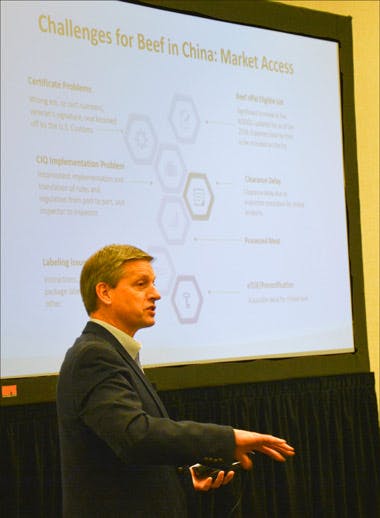Export Growth Committee Reviews Results, Examines International Priorities
The Beef Checkoff Program’s Export Growth Committee met Friday, Feb. 2 at the Cattle Industry Annual Convention in Phoenix. The committee, which is made up of cattle producers and other beef industry leaders from throughout the nation, is co-chaired by Clark Price, a cow-calf producer and cattle feeder from Hensler, North Dakota, and Hugh Sanburg, a cow-calf producer from Eckert, Colorado, who also serves on the USMEF Executive Committee.

Co-chairs Hugh Sanburg (left) and Clark Price open the Feb. 2 meeting
of the Beef Checkoff Program’s Export Growth Committee
The committee received a summary of 2017 export results for U.S. beef from Dan Halstrom, USMEF president and CEO. Halstrom noted that exports set a new value record ($7.27 billion) and equated to more than $285 per head of fed slaughter. He provided a breakdown of the per-head value added by each major market, including Japan ($75), South Korea ($47), Mexico ($38) and China/Hong Kong ($34). Halstrom also explained the importance of moving each part of the beef carcass to the market that values it most.
“When was the last time any of you had beef lips?” Halstrom asked the committee. “Beef lips are worth more than $2 per pound today, and virtually all of them are exported to Mexico. So we get $2 per pound verses the rendered value, which amounts to about $4 per head. This is a great example of putting the right cut in the right market to match up with the cultural demand.”

USMEF President and CEO Dan Halstrom speaks to Export Growth Committee members about U.S. beef’s growing presence in Africa
Greg Hanes, USMEF assistant vice president for international marketing and programs, explained the factors driving outstanding demand for U.S. beef in Japan, the U.S. industry’s leading volume and value market. But he cautioned that U.S. exports to Japan face increasing headwinds, including a widening tariff gap compared to Japan’s imports of Australian beef and the possibility that imports from other key competitors could soon gain tariff relief in Japan through the Comprehensive and Progressive Agreement for Trans-Pacific Partnership (CPTPP) – the trade agreement being forged by the 11 remaining members of the Trans-Pacific Partnership.
Hanes also reviewed the early export results for China, which reopened to U.S. beef in mid-2017 after more than a 13-year absence. U.S. beef has been very well-received, and China is already one of the best-performing markets for U.S. beef in terms of value per pound. Volume growth will take time, however, as China’s import requirements limit eligible supplies.
John Hinners, USMEF assistant vice president for industry relations, focused on the rapid growth of U.S. beef exports to South Korea, which set a new value record in 2017 of $1.22 billion – up 15 percent year-over-year. He noted that less than 10 years ago, the U.S. industry faced strong resistance from Korean consumers, as well as some retailers and foodservice operators. But today, thanks to checkoff-funded efforts, consumer confidence has been restored in Korea, beef consumption is climbing and U.S. exports are reaching new heights.

Greg Hanes, USMEF assistant VP of International marketing and programs, addresses the early results for U.S. beef in China
“If I ever saw a time when your beef checkoff dollars were wisely invested, it was during that time in Korea,” Hinners told the committee. “Thanks to that investment, we’ve had a lot of success rebuilding this particular market.”
Philip Seng, USMEF CEO emeritus, previewed the upcoming 2018 World Meat Congress (WMC) and encouraged committee members to attend. He noted that U.S. Agriculture Secretary Sonny Perdue will address the WMC on May 31, and additional speakers will be announced soon. The WMC is set for May 30-June 1 in Dallas, and more information is available online.
When establishing initiative priorities for Fiscal Year 2018, the Export Growth Committee unanimously renewed its priorities from the previous year:
Adopt Animal I.D. Traceability
Increase Market Access
Promote Unique Attributes of U.S. Beef
A meeting of the National Cattlemen’s Beef Association (NCBA) International Trade Committee was also held Feb. 2 in Phoenix. One of the actions taken at this meeting was to expand NCBA’s policy on beef grading reciprocity – which was done in response to Mexico’s proposed beef grading standards. USMEF filed comments on these proposed standards in December, which were discussed in detail in the Dec. 22 Export Newsline.
At the committee meeting, representatives from the Texas Cattle Feeders Association and the Kansas Livestock Association proposed the following addition to NCBA policy (new language is underlined):
Grading Reciprocity
WHEREAS, the United States Department of Agriculture (USDA) beef grading system and grade stamp is recognized worldwide as the symbol of the highest beef quality,
THEREFORE BE IT RESOLVED, NCBA oppose any reciprocity of standards and services of the USDA beef grades outside of the United States,
BE IT FURTHER RESOLVED, NCBA oppose any effort in other countries to utilize the USDA beef grading system or its associated terms.
The policy amendment was approved by the International Trade Committee and received approval the following day from the NCBA Board of Directors. It will remain a temporary resolution until the Cattle Industry Summer Business Meeting (Aug. 1-4 in Denver), when all new NCBA policy passed at the Cattle Industry Annual Convention must be renewed or allowed to expire.
